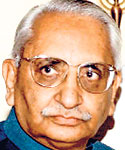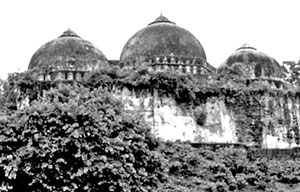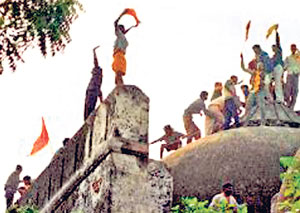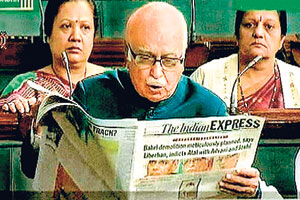An element of cynicism was always there as the central characteristic of the Justice Manmohan Singh Liberhan Commission during the 17 long years that it took to probe the December 6, 1992, demolition of the Babri Masjid in Ayodhya, perceptible in many ways - when the commission obtained 48 extensions from various Central governments, when allegations broke out of slow-pedalling of the inquiry against certain politicians, and when there was a rather public spat between the commission's chief and its counsel.
Finally, the government tabled the report in Parliament on November 24 under tremendous pressure, after a newspaper published portions of it a day earlier. The government was left with no option but to forsake its six-month-long inertia since the submission of the report on June 30. This final sequence of events as well as the contents of the report have set in motion several debates and also controversies, in the political, legal and social realms.
 |
| Justice Liberhan |
Even so, the central conclusion of the four-volume report running into over 1,000 pages is by and large seen as a mere repetition of what has been common knowledge for long. It is that the Rashtriya Swayamsewak Sangh (RSS) and its affiliates such as the Vishwa Hindu Parishad (VHP), the Bajrang Dal and the Bharatiya Janata Party (BJP), which make up the Sangh Parivar, were responsible for the demolition.
The commission has also held that the BJP government in Uttar Pradesh, led by Kalyan Singh, and some of its officers colluded with the Sangh Parivar in a "duplicitous and under-handed manner" "not worthy of a democratically elected government".
The report further states:
"When push came to shove, the senior police officers were at hand to ensure their men toed the line and that the demolition of the disputed structure was allowed to go ahead with military precision as orchestrated by the leaders present at the spot and carried out by their henchmen whom they refused to identify even before me.
"By far the worst sin of omission of the State government was leaking into public domain the information that the police personnel had been hobbled and would not react or retaliate under any circumstances. Emboldened by the self-confessed handicap of the law enforcement agencies of the State, the kar sevaks enjoyed a free hand, aware that they were at zero risk from them. Even the forces demanded by the State government and sent by the Central government for security purposes were intentionally taken away from the scene and deployed at far away places under the garb of meeting the threat of terrorism."
 |
| Top: Babri masjid before destruction. Bottom: Sangh Parivar activists demolishing the mosque |
 |
At the individual level, the commission has listed 68 persons, including Sangh Parivar leaders and officials of the then Uttar Pradesh government, as responsible "for leading the country to the brink of communal discord". The Sangh Parivar leaders listed include BJP stalwarts such as former Prime Minister Atal Bihari Vajpayee, former Deputy Prime Minister and Ayodhya Rath Yatra leader Lal Krishna Advani and former Union Human Resources Development Minister Murli Manohar Joshi.
The commission terms these leaders "pseudo moderates" who were controlled by the diktats of the RSS. It also says that RSS, Bajrang Dal and VHP leaders such as Ashok Singhal, K.S. Sudarshan and Vinay Katiyar formed a "complete cartel" supported by icons of the Hindutva movement such as Advani, Joshi and Vajpayee.
The overall conclusion of the report, holding the Sangh Parivar responsible for the demolition, has been received with near-total approval by the main political organisations. But the emphasis it gives to certain players within the Sangh Parivar, such as Vajpayee, and the clean chit given to the P.V. Narasimha Rao-led Congress government at the Centre have not received the same level of acceptance. Reservations have been expressed not only in the political but also in judicial terms. While the BJP is naturally in the forefront of opposing the inclusion of Vajpayee among those held guilty, the centrist and Left opposition parties question the clean chit given to the Narasimha Rao government.
Anupam Gupta, former counsel of the commission, who left his position in 2007 owing to differences with Justice Liberhan, told Frontline that the inclusion of Vajpayee in the list of people with individual culpability was not legally tenable. He pointed out that the commission passed a detailed order on July 22, 2003, rejecting an application to summon Vajpayee on the grounds that there was no evidence on record against him.
"At that time, the controversial speech made by Vajpayee on December 5 at Lucknow, suggesting the demolition of the Babri Masjid, had not come to the commission's notice. Even when the story about a CD containing that speech was published, it was not taken notice of by the commission. The right thing to do would have been to summon Vajpayee at that time. Without doing that, how can the commission arrive at such an astonishing finding?" Gupta asked.
He maintained that the clean chit given to the Narasimha Rao administration could only mean that the commission had failed to consider carefully all the documents and reports of various security and intelligence agencies it had access to. "The exoneration of the Narasimha Rao government points only towards a sell-out," Gupta told Frontline.
The commission, on its part, has analysed the standards of culpability and categorised them as primary, secondary and tertiary. Those who had the primary and greatest responsibility for the demolition are those that had the means to prevent the assault. Many in the top leadership of the RSS, the VHP, the Bajrang Dal and the Shiv Sena come in this group.
The second group consists of those who portrayed a benign public face of the Ayodhya campaign and gave false assurances to the courts, the people and the nation. "Those who have been put in the second category in these conclusions are referred to as 'pseudo-moderates' in contrast to the radicals forming part of the first group," the report says. "On the one hand, leaders like A.B. Vajpayee, Murli Manohar Joshi and L.K. Advani, who are the undeniable public face and leaders of the BJP and thus of the Parivar, constantly protested their innocence and denounced the events of December 1992. On the other hand, it stands established beyond doubt that the events of the day were neither spontaneous, nor unplanned, nor unforeseen overflowing of the people's emotions, or the result of a foreign conspiracy as some overly imaginative people have tried to suggest."
The report also holds that "all these three groups had managed to reduce one of the greatest nations and one of the oldest civilisations to the state of stark intolerance and barbarianism - all for petty political gains".
The report states categorically that the pseudo-moderates cannot be held innocent of any wrongdoing and points out that "it cannot be assumed even for a moment that L.K. Advani, A.B. Vajpayee or M.M. Joshi did not know the designs of the Sangh Parivar". "Even though these leaders were deemed and used by the Parivar as the publicly acceptable faces and the articulated voices of the Parivar and thus used to reassure the cautious masses, they were party to the decisions which had been taken."
The report also points out that the BJP leadership was "as much a tool in the hands of the RSS as any other organisation or entity, and these leaders stood to inherit the political successes engineered by the RSS".
It makes a reference to the famous remark of former BJP leader Govindacharya, who termed Vajpayee as a mukhota (mask) and states that the remark can be "more appropriately applied to the BJP leadership at the time collectively".
Surprisingly, despite such strong and trenchant observations and conclusions on those held culpable, no specific legal measures have been suggested in the recommendations section, either against organisations or against individuals deemed as guilty. Instead, the recommendations contain broad propositions for the enactment of new laws to prevent and control riots and the setting up of special courts to deal with cases coming under the purview of the new Act.
The recommendations section calls for a law providing for exemplary punishment for the misuse of religion for acquiring political power and the disqualification of political parties and candidates who have religious agendas.
Referring to these observations, Zafrayab Jilani, leader of the The Babri Masjid Action Committee [BMAC] and a member of the Muslim Personal Law Board, told Frontline that Justice Liberhan had obviously overshot his brief and the parameters of the commission. He added that Muslim organisations had never been summoned and if that had been done they could have got an opportunity to delineate what they were doing for the community. "The commission has made a wild comment without even considering that our stand on the Babri Masjid issue has been consistent right from the 1950s," Jilani told Frontline. Clearly, the report has evoked more critical responses than favourable ones even from groups that should be happy with the indictment of the Sangh Parivar.
For civil society as a whole, the long and controversial history of the Justice Liberhan Commission only underlines the futility of such exercises. Almost all such inquiry commissions have failed to come up with anything tangible, be it the Nanavati Commission that probed the anti-Sikh riots of 1984 or the Srikrishna Commission that looked into the Mumbai riots of 1992-93. The ATRs on these commissions have also nothing concrete to show, and the early trends of the Liberhan Commission ATR point to a similar ending.
Courtesy Frontline, India
In the name of religion…
A timeline of events relating to the Babri Masjid demolition and its aftermath
1528 A mosque is built on the site which some Hindus claim is the birthplace of Lord Rama
1859 After first recorded violence in 1853, the British administration erects a fence to
separate the places of worship, allowing the inner court to be used by Muslims and the outer one by Hindus.
 |
| Advani in parliament asks who leaked the report to the media |
1949 Idols of Lord Rama appear inside mosque, placed allegedly by Hindus. Muslims protest; both parties file civil suits. Premises are proclaimed 'disputed' and gates are locked.
1984 Hindus under the VHP decide to build a Ram temple at his birthplace.
1986 To appease Hindus, the district judge at Ayodhya is ordered to open the gates of the mosque. It allows Hindus to worship there. Muslims protest.
1989 VHP steps up campaign, laying the shilanyas (foundation) of a Ram temple on land adjacent to the disputed mosque
Sep 1990 Advani begins rath yatra, fostering discord which flared up into riots post-demolition
Dec 6, 1992 The mosque is demolished by radical Hindu groups as senior BJP leaders watch. Riots break out across India, 2,000-odd dead.
Dec 16, 1992 The M.S. Liberhan Commission is set up to inquire into the demolition
Feb 2002 VHP sets deadline for temple construction. Hundreds of kar sevaks arrive in Ayodhya. On their return, 58 of them are killed in the Godhra train fire.
Mar 2002 Over 2,000 die in the post-Godhra riots in Gujarat
Sep 2003 A court rules that seven Hindu leaders should stand trial for inciting the Babri destruction, but no charges are brought against L.K. Advani
JUL 2005 Disputed site is attacked by terrorists. Security forces kill five militants.
Nov 2009 The Liberhan report is tabled hurriedly in Parliament after it's leaked to a daily.
Courtesy outlookindia.com
|




